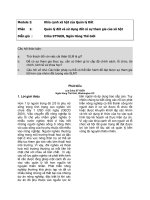Mastering The Essentials of Sales_9 doc
Bạn đang xem bản rút gọn của tài liệu. Xem và tải ngay bản đầy đủ của tài liệu tại đây (595.68 KB, 18 trang )
Why? Because the decision-
making process has migrated
upward, and salespeople are
struggling to make connec-
tions with these upper-level
executives. What’s the solu-
tion? Bring higher-level execu-
tives to make joint calls with
your salesperson.
2. Real solutions are
harder to justify. Many times
salespeople propose a great so-
lution that will do wonders for
their client. The only problem
is that the client does not see
enough benefits to justify the purchase. Why? Be-
cause many companies, still in a budget-saving
mode, don’t even think beyond the current quarter.
The solution: Spend more time mapping the pain
points in the earlier phases of the call. Ask the client
to put a dollar figure next to each pain. Justify the
economic wisdom of your solution by using your
client’s numbers.
3. Friendly relationships are not always produc-
tive. Some salespeople work hard on making every
call a pleasant experience. Yet they are often sur-
prised when a competitor calls on their client and
walks away with a sale, leaving them empty handed.
Why? Because some salespeople have a strong need
to be liked, and their need for approval prevents them
from asking some of the tough questions that would
MASTERING THE ESSENTIALS OF SALES
200
ACTION TIP
When sales slow down,
think of three things
that are in your control
that you can speed up.
You can call more new
prospects; you can call
more existing clients;
and you can ask for more
referrals or think of new
selling ideas. There is no
slowdown for people
who can think on
their feet.
advance the sale and actually help the customer
make a favorable decision. The solution: Get these
salespeople to switch from the “farming” style to the
“hunting” style. If coaching fails, move them to cus-
tomer service.
4. With sales being slow, it’s more difficult to cut
off problem clients. While sales managers preach
that every sale counts, they often fail to count the
time and expense it takes to close certain sales. The
solution: Give your sales team clear directions for
when to say no to a client.
5. When business is slow, creative ideas are
harder to find. While it’s easy to say that sales
problems are nothing but wake-up calls for creativ-
ity, salespeople are often hard-pressed to come up
with new ideas for increasing sales. Why? Because
they think that they’ve tried everything under the
sun. The solution: Pull in your top performers and
list all the best ideas that worked for them. Then ask
your top performers to act as mentors to your sales
team.
6. When business shrinks, salespeople get con-
fused about your expectations. Why? In tough
times salespeople worry more about their jobs and
their income. The solution: Don’t add to their stress
with unrealistic expectations or ambiguous leader-
ship. Offer a clear vision of the future and create a
solid plan that leads to new opportunities. Salespeople
respect what you fairly expect and impartially inspect.
MASTERING THE ESSENTIALS OF SALES
201
This page intentionally left blank
203
T
he best people in any profession work efficiently and ef-
fectively. The best carpenters make the fewest chips.
Time and motion studies of world-class soccer players re-
veal that the top-rated players run far shorter distances
and score more goals during a game than their less suc-
cessful colleagues. At his peak level, basketball star
Michael Jordan always gave 100 percent of himself in
every game, yet he always had a little power reserve that
he accumulated by playing efficiently. While poor perform-
ers turn part of their energy into waste, top performers
save up energy and invest it effectively in last-minute,
victory-saving bursts of performance.
HOW EFFECTIVE ARE YOUR
SALES CALLS?
50
Copyright © 2006 by Gerhard Gschwandtner. Click here for terms of use.
Management experts will tell you that it is better to be
effective than efficient. According to Daniel Stamp, the
founder of Priority Management Systems, effectiveness is
doing the right thing, whereas efficiency is doing things
right. To improve our sales results, we need to improve
both efficiency and effectiveness.
Here are three simple principles to remember when you
meet your next customer:
1. First, an effective listener sells more than an
efficient talker. The better you listen to your
prospect, the less time it will take you to pinpoint the
essence of your prospect’s needs. Remember the soc-
cer player who runs less but scores more goals? As
you listen more effectively, you won’t chase the sale;
you’ll allow the sale to come to you. As an effective
listener you won’t answer questions that were never
asked or present solutions that don’t fit the cus-
tomer’s problem.
2. Second, your customers’ erroneous beliefs
weigh more in their minds than a prize bull at
the state fair. Psychologist
Robert Abelson once proposed
the idea that we treat beliefs
like material possessions. Cus-
tomers form their beliefs with
great care, and they don’t want
you to shatter them. What do
top performers do when they
face erroneous beliefs such as
“The competitor’s product is
MASTERING THE ESSENTIALS OF SALES
204
REMINDER
If you don’t ask
questions that lead you
to the customer’s needs,
you won’t be needed by
your customer or
your company.
better”? They don’t challenge their customer’s be-
liefs. A more effective strategy is to shift the focus
back from the solution to the original problem. In-
stead of proving to the customer that they don’t have
the right solution, they lead their customers to care-
fully review the true nature of their problem. When
customers review and restate their problem, it will
often change in their minds. Once the problem defi-
nition changes, chances are that the competitive so-
lution will no longer fit and the effective salesperson
can introduce a far better solution.
3. Third, it is more effective to pull the toughest
problems out of a prospect’s mind than to push
the best solution. The toughest job in selling is to
find, isolate, and clearly define your prospect’s real
problem. Chances are that your prospect has not had
the time to clearly define the problem at hand. Top
performers know that an inefficient analysis of a
problem will lead to an inefficient solution. If you
spend more time agreeing with the customer on the
problem, you will spend less time selling the solu-
tion. Why? Because a clearly stated problem takes
away the customer’s confusion—and as a result, the
customer will think of you as the more effective
salesperson and buy from you. Isn’t it more efficient
to be effective?
MASTERING THE ESSENTIALS OF SALES
205
This page intentionally left blank
207
I
n Europe where I grew up, we always associated the
name Cadillac with the best of the best. In my home
country, Austria, American automobiles were a novelty. A
privileged few owned Ford Mustangs. You could see Ameri-
can tourists in Buicks and Chevrolets, but only the wealth-
iest Austrians cruised the streets of Salzburg in a Cadillac.
Mr. Winkler, the owner of the city’s largest hotels, became
the best-known car owner in town by treating himself to a
brand-new Cadillac every year. His latest model always
made newspaper headlines in Salzburg.
I was still riding a bicycle when I first studied Mr. Win-
kler’s car up close, wondering just how many horses were
CADILLAC DREAMS
51
Copyright © 2006 by Gerhard Gschwandtner. Click here for terms of use.
harnessed by this sleek metal sculpture on wheels. For me,
a Cadillac was the stuff of dreams. Over the years, I
learned more about Cadillac’s amazing achievements. The
company’s steady pursuit of quality and continuous search
for ongoing improvement earned Cadillac an enviable
place in automotive history. For example, Cadillac was the
first car company to replace the unwieldy hand-crank
starter with an electric starter for its 1912 models.
This idea originated at National Cash Register, the
company that spawned modern selling techniques. NCR
engineer Charles Kettering developed an electric motor
that provided short bursts of power for cash registers.
When Cadillac hired him, Kettering adapted his idea to car
engines. His battery-powered starter kept Cadillac sales
soaring.
When I moved to America, I first bought a Volkswagen,
a decision I soon regretted, since it had no air conditioning.
Two years later, I switched to an American coupe and then
to a station wagon to accommodate the demands of a grow-
ing family. As our business expanded and prospered, my
nostalgia for Cadillac cars drove me to trade in my station
wagon for a sleeker and more businesslike Seville.
The Cadillac salesman, a 25-year veteran of car sales,
convinced me that I deserved to turn my Austrian/Ameri-
can dream into reality. He pointed out that I deserved the
very highest standard of quality.
To me the name Cadillac represents more than quality,
the Baldrige Award, or Gold Key service. The Cadillac crest
is a symbol of the pioneering and leadership qualities of its
namesake, Antoine de la Mothe Cadillac, who was born in
France in 1658 and came to America to found a settlement
MASTERING THE ESSENTIALS OF SALES
208
he called La Ville d’Etroit in
1701, which later became the
Motor City, Detroit.
When I took a test drive in
the new Seville to get a feel of
the famous Northstar engine,
it was a thrill. I slipped in a
CD, took a whiff of the new car
smell, and for a brief moment I
felt like Mr. Winkler and real-
ized that quality cars are not
only a means of transportation,
but a means of transformation.
While many people like to
sing while they are driving, I like to think of famous movie
lines. As I drove down the highway the first line that came
to my mind was that of a comedian named Smirnoff: “Amer-
ica, what a country!” A country built by immigrants who
dared to dream.
MASTERING THE ESSENTIALS OF SALES
209
SUCCESS PRINCIPLE
If somebody with a name
that nobody can
pronounce can come to
this country with no
money and start a
magazine and actually
succeed, what does that
tell you? Those who feel
they have nothing to lose
are the least afraid of
taking a risk.
This page intentionally left blank
INDEX
211
A
Abelson, Robert, 204–205
Achievement (See Success)
Act “as if ” strategy, 151–153
Action orientation, 147–149
An Actor Prepares (Stanislavski), 151,
153
Adventure, life as, 175–177
Adversity, 159–161
Adversity Quotient (Stoltz), 159
Alberti (Italian architect), 33
Amateurs vs. professionals, 21–23
Armstrong, Lance, 149
Ash, Mary Kay, 6, 152
Attitude
“bad news,” 93–95, 169
professional, 23
slow economy, 74–75
winning, 179–181
B
“Bad news,” 93–95, 169
Behar, Howard, 148
Bell, Alexander Graham, 172
Boorstin, Daniel, 179
Brain, stimulation of, 143–145
Branson, Richard, 177
Brunelleschi (Italian architect), 33
Bush, George H.W., 6
Buyers (See Customers)
C
Cadillac, 207–209
Cadillac, Antoine de Mothe, 208–209
Care, teamwork, 47
Career decisions, 59, 167–169
Carey, T.J., 10
Carrison, Don, 54
Change, managing, 29–31, 77–79
Charting sales progress, 131–133
Choice, teamwork, 47
Cleese, John, 6
Closing and golf, 187–189, 191–193
Coca-Cola, 136
Collections of receivables, 74
Commitment, 23, 46, 55
Communication, 14, 46, 139–142, 204
Company, new, 167–169
Compass of achievers, 172–173
Competition, 29–31, 133, 195–197
Concentration, 119–121
Concessions, 75
Convergent thinking, 141–142
Coping, 73–76, 81–83, 199–201
Corporate culture, 26–27, 29–31
Covey, Stephen, 181
Creativity, 19, 46, 89–91, 119–120, 201
Csikszentmihalyi, Mihaly, 120
Culture, corporate, 26–27, 29–31
Curie, Marie, 116–117
Curiosity, 115–117
The Customer Driven Company
(Whitely), 181
Customers
attitude toward, 181
cultivating new idea, 90
focus on, 21, 25–27, 204–205
lessons learned about, 199–201
message management, 67, 69–71
new company view of, 168
prospecting, 65–67, 132
sales progress, 131–132
selling solutions, 22–23, 93–95, 200
slow economy, 73–76, 85–87
unprofitable, 86, 201
D
Da Vinci, Leonardo, 108
Dell, Michael, 6, 29, 177
DeVos, Rich, 180
Diamond analogy, 37–39
Disappointment, 102–103, 163–165
Divergent thinking, 141–142
Diversity, teamwork, 46
Downs, Hugh, 6
“Drummers,” 9–10
Copyright © 2006 by Gerhard Gschwandtner. Click here for terms of use.
E
Eastman, George, 65
Economy (See Slow economy)
Edison, Thomas A., 116, 121
Efficiency, 62, 74
Ego strength, 156–157
Ellison, Larry, 175
Emerson, Ralph Waldo, 17, 18
Employer, new, 167–169
Energy, 111–113, 149, 179–181
Ethical issues, 49, 63, 74
F
Failure, 79, 82, 155–157
Farley, Frank, 176
“Farming” sales style, 201
“Flow,” 120, 176
Focus
concentration, 119–121
on customers, 21, 25–27, 204–205
golf, 195–196
maintenance of, 58, 123–125
on productivity, 127–129
Foreman, George, 6, 124
Four C’s of management, 37–39
Francis, Brendan, 119
Friendliness and sales, 200–201
G
Game plan improvement, 195–197
Goals, 113, 129, 164
Golf, 187–189, 191–193, 195–197
Greenspan, Alan, 101
Grove, Andy, 6
H
Happiness, creation of, 183–185
Hart, John, 144
Hiring, Marine method, 54
Holtz, Lou, 47
Homer, 173
“Hunting” sales style, 201
I
Icarus, 107
Ideas, 5–6, 8, 19, 83, 89–91, 201
The Iliad (Homer), 173
Impatience, achievers, 171–172
Information (See Knowledge and
training)
Intention, and success, 124–125
Interdependence, teamwork, 46
“Invisible circle,” 153
J
Jamieson, Kathleen Hall, 94
Jefferson, Thomas, 91
Jordan, Michael, 203
K
Kearns, David, 31
Kellogg, 57–58
Kettering, Charles, 208
King, Larry, 6
Knowledge and training
acquisition of, 17–19
action orientation, 147–149
and change, 30
concentration, 119–121
curiosity, 115–117
disappointment, 164–165
libraries, 17–18
Marine method, 54
negative information, 93–95, 169
Patterson and, 10–11, 13–15
perspective, 33–35
power of language, 135–137
professional, 9–11, 21–23, 49–51
profit improvement, 62–63
triangle of sales success, 41–43
and wisdom, 19
Zeitgeist awareness, 101–103
L
LaMantia, Charles, 30
Language power, 135–137
Larsen, Randy, 176
Leadership (See Management and
leadership)
Lear, Norman, 120
Leibnitz, Wilhelm, 18
Libraries, and knowledge, 17–18
INDEX
212
Liemandt, Joe, 176
Listening, 14, 204
Loyalty, 55, 86–87
Loyalty Rules (Reichheld), 86–87
M
MacMillan, Ian, 177
Management and leadership
action orientation, 148–149
adversity management, 159–161
attitude toward, 180
change as positive, 29–31
consistent achievement, 57–59
core marketing message, 70–71
customer-centered selling, 25–27
Four C’s of, 37–39
fuel for success, 113
game plan improvement, 195–197
lack of, 149
lessons learned, 199–201
Marine method, 54–55
profit improvement, 61–64
selling an idea, 89–91
triangle of sales success, 41–43
Zeitgeist, 101–103
Marine Corps, 53–55
Marketing messages, 65–71
McMahon, Ed, 152
Meaning, 78–79, 112, 164
Mehrabian, Albert, 144–145
Messages, marketing, 65–71
Messner, Reinhold, 172
Montaigne, Michel de, 184
Motivation
act “as if ” strategy, 151–153
action orientation, 147–149
fuel for success, 111–113
Marines approach, 53–55
ten-point plan for success, 78
triangle of sales success, 41–43
N
NCR, 10–11, 208
Negative information, 93–95, 169
New employer, 167–169
The New York Times, 94, 97–99
O
Ochs, Adolph, 97–98, 99
Opportunities, 128, 199–200
Optimism, 160–161
P
Palmer, Arnold, 119
Patterson, John Henry, 10–11,
13–15
Paulinus, 185
Peale, Norman Vincent, 179–180
Persistence, 59
Perspective, 33–35, 168–169
Pessimism, 160–161
Peters, Tom, 31
Planning, 74, 77–79, 107–109
Plato, 183
Potter, Beverly, 176
Practice, 196
“Prime-time” activities, 132–133
Priority Management Systems, 204
Problems, solutions to, 22–23, 93–95,
200, 204–205
Procrastination, 148–149
Productivity, 15, 63, 127–133
Professionalism, 9–11, 21–23,
49–51
Profit improvement, 61–64
Progress, 101–103, 131–133, 168
Prospecting, 65–67, 132
(See also Customers; Sales calls)
Psycholinguistics, 144
R
Receivables, collection of, 74
Recession-survival strategies, 73–76
(See also Slow economy)
Recruiting, Marine method, 54
Reichheld, Frederick F., 86–87
Results and productivity, 15, 63,
127–133
Riley, Pat, 46, 180
Ripken, Cal, Jr., 6
Roadmap for sales call, 140–141
Robbins, Tony, 6
Roosevelt, Theodore, 15, 149
INDEX
213
S
Sales (See specific topics)
Sales calls
act “as if ” strategy, 151–153
effectiveness, 203–205
prospecting, 65–67, 132
tailored messages, 66
talking excessively, 139–142, 204
Salespeople, number in U.S., 21
Schacht, Henry, 82
Schliemann, Heinrich, 173
Schopenhauer, Arthur, 35
Schwarzkopf, Norman, 6, 45
Secrets of achievers, 171–173
Self-deception and failure, 82
Seligman, Martin, 160
Selling Power (magazine), 3–8, 27, 31,
89–90, 120, 124
Semper Fi (Carrison), 54
Shaw, H.W., 148
Skills (See Knowledge and
training)
Slow economy
coping, 73–76, 81–83, 199–201
customer financial health, 73, 75
customer satisfaction, 85–87
as incubator of growth, 81–83
sales vs. marketing, 70–71
ten-point plan for success, 77–79
Smirnoff (comedian), 209
Smith, Fred, 177
Software piracy, 50
Solutions, selling, 22–23, 93–95, 200
Stallone, Sylvester, 125
Stamp, Daniel, 204
Stanislavski, Constantin, 151, 153
Statler, E.F., 10
Stoltz, Paul, 159
Success
act “as if,” 151–153
charting progress of, 131–133
consistent, 57–59
energy, 111–113, 149, 179–181
intention, 124–125
meaning, 78–79, 112, 164
planning, 45, 77–79, 107–109
Success (Cont.)
secrets of, 171–173
(See also specific topics)
Sulzberger, Arthur Ochs, 98
T
Talking, excessive, 139–142, 204
Teamwork
action orientation, 148–149
attitude toward, 180–181
Four C’s, 38–39
as fundamental, 45–47, 113
Technology, 78
Ten-point plan, 77–79
Tested Sentences (Wheeler), 66
Thrill seeking, 175–177
Training (See Knowledge and
training)
Triangle of sales success, 41–43
Trump, Donald, 6, 89–90
Trust, 49–51, 79
U
UPS, 58
V
Values, 58–59, 75–76, 168
Vietnam War POWs, 185
Vision, 45, 77–79, 107–109
Vocabulary, power of, 135–137
W
Watson, Thomas, Sr., 11
Wheeler, Elmer, 66
Whitely, Richard C., 181
Winning attitude, 179–181
Wisdom, 19, 196
Word power, 135–137
Wright, Orville and Wilbur, 108
Z
Zaleznik, Abraham, 163
Zeitgeist, 101–103
Ziglar, Zig, 6
“The zone,” 120
Zubrin, Robert, 173
INDEX
214
About the Author
A dual citizen of both Austria and the United States, Ger-
hard Gschwandtner is the founder and publisher of Sell-
ing Power, the leading magazine for sales professionals
worldwide, with a circulation of 165,000 subscribers in 67
countries.
He began his career in his native Austria in the sales
training and marketing departments of a large construc-
tion equipment company. In 1972, he moved to the United
States to become the company’s North American Sales
Training Director, later moving into the position of Mar-
keting Manager.
In 1977, he became an independent sales training
consultant, and in 1979 created an audiovisual sales
training course called “The Languages of Selling.” Mar-
keted to sales managers at Fortune 500 companies, the
course taught nonverbal communication in sales together
with professional selling skills.
In 1981, Gerhard launched Personal Selling Power, a
tabloid format newsletter directed to sales managers.
Over the years the tabloid grew in subscriptions, size, and
frequency. The name changed to Selling Power, and in
magazine format it became the leader in the professional
sales field. Every year Selling Power publishes the “Sell-
ing Power 500,” a listing of the 500 largest sales forces in
America. The company publishes books, sales training
posters, and audio and video products for the professional
sales market.
Gerhard has become America’s leading expert on sell-
ing and sales management. He conducts webinars for
such companies as SAP, and Selling Power has recently
launched a new conference division that sponsors and
conducts by-invitation-only leadership conferences di-
rected toward companies with high sales volume and
large sales forces.
For more information on Selling Power and its prod-
ucts and services, please visit www.sellingpower.com.
© Hisham Bharoocha
Copyright © 2006 by Gerhard Gschwandtner. Click here for terms of use.
MAXIMUM IMPACT
for any Sales Career
AVAILABLE EVERYWHERE BOOKS ARE SOLD
Visit us at www.sellingpower.com
For bulk purchases contact Shavonne Boyd at (212) 904-5427 or
Everything I Know About
Sales Success
Sales Scripts That
Close Every Deal
201 Super Sales Tips
Mastering the
Essentials of Sales
The Pocket Guide to
Selling Greatness
Be In It to Win
Subscribe to Selling Power today
and close more sales tomorrow!
GET 10 ISSUES – INCLUDING
THE SALES MANAGER’S SOURCE BOOK
.
In every issue of Selling Power magazine you’ll find:
■ A Sales Manager’s Training Guide with a one-hour
sales training workshop complete with exercises and
step-by-step instructions. Get a new guide in every issue!
Created by proven industry experts who get $10,000 or
more for a keynote speech or a training session.
■ Best-practices reports that show you how to win in
today’s tough market. Valuable tips and techniques for
opening more doors and closing more sales.
■ How-to stories that help you speed up your sales
cycle with innovative technology solutions, so you’ll stay
on the leading edge and avoid the “bleeding edge.”
■ Tested motivation ideas so you and your team
can remain focused, stay enthusiastic and prevail in
the face of adversity.
FOR FASTEST SERVICE CALL 800-752-7355
TO SUBSCRIBE ONLINE GO TO WWW.SELLINGPOWER.COM
Plus, you can sign
up for five online
SellingPower.com
newsletters
absolutely FREE.
Name: _____________________________________ Title: ____________________________
Company: ______________________________________________________________________
Address:______________________________________________________________________
City: _________________ State: _____ Zip: ___________ Phone: ____________________________________________
■■ Check enclosed Charge my ■ Visa ■ MC ■ AMEX ■ Discover
Card number: __________________________________ Exp.:____________________________
Name on card: _______________________ Signature: ________________________________
■ YES! Send me one year of the print edition for only $27
■ YES! Sign me up for one year of the digital edition for only $19
■ YES! Sign me up for one year of both for only $33
Please note: Subscriptions begin upon receipt of payment. For priority service include check or credit card information.
Canadian and overseas subscriptions, please visit www.sellingpower.com for rates.
I want a one-year subscription to Selling Power magazine.
For fastest service call 800-752-7355
●
To subscribe online go to www.sellingpower.com
NEW!
Digital Edition
same as print.
100% online.









